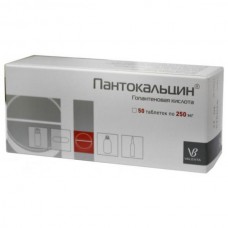Expiration date: 06/2026
The composition and form of issue:
Tablets. 1 tablet contains active substance:
calcium hopantenate (pantogram or calcium salt gopantenova acid) 0.25 or 0.5 g
Excipients: magnesium hydroxycarbonate calcium stearate talc starch
in a contour acheikova packing 10 PCs. in cardboard pack 5 packs or in cans polymer of 50 PCs the paper cartons 1 Bank.
Description pharmaceutical form:
Pills white valium form with a facet and valium.
Pharmacokinetics:
If ingestion is rapidly absorbed from the gastrointestinal tract. The time to reach Cmax in plasma is 1 h. Highest concentrations are in the liver, kidney, stomach wall, skin. Penetrates the GEB. Is not metabolized and is excreted unchanged within 48 hours (67,5% of the dose from urine, 28,5% in the feces).
Description pharmacological action:
The spectrum of action is associated with the presence in the structure of GABA. The mechanism of action is due to the direct influence of Pantocalcin on GAMB-receptor-channel complex. Has neurometabolic, neuroprotective and neurotrophic properties. Increases the brain resistance to hypoxia and exposure to toxic substances, stimulates anabolic processes in neurons. It has anticonvulsant effect, reduces the excitability of the motor with the simultaneous regulation of behavior. Enhances mental and physical performance. Contributes to the normalization of the content of GABA in chronic alcohol intoxication and the subsequent lifting of ethanol. Exhibits analgesic action. Able to inhibit the acetylation reaction involved in the mechanisms of inactivation of procaine and sulfonamides, resulting in the prolongation of the action of the latter. Causes inhibition of pathologically increased gallbladder reflex and tone detruzora.
Indications:
- cognitive disorders in organic brain lesions and neurotic disorders
- in the complex therapy of cerebrovascular insufficiency caused by atherosclerotic changes of cerebral vessels, senile dementia (primary form), residual organic brain damage in people of Mature age and older
- cerebral organic insufficiency in patients with schizophrenia (in combination with neuroleptics, antidepressants)
- extrapyramidal hyperkinesis in patients with inherited diseases of the nervous system (Huntington's chorea, hepatolenticular degeneration, Parkinson's disease, etc.)
- consequences of neuroinfections and head injury (in the complex therapy)
- correction and prevention (therapy cover while the appointment) side effects of neuroleptics neuroleptic extrapyramidal syndrome (hyperkinetic and akinetic)
- epilepsy slowing of mental processes (in combination with anticonvulsants)
- stress, reduced mental and physical performance to improve concentration and memory
- urinary disorders: enuresis, daytime urinary incontinence, pollakiuria, urgent need
Children:
- mental retardation (mental delay, speech, motor development or a combination of them)
- cerebral palsy
- stuttering (mostly clonic form)
- epilepsy (in combination therapy with anticonvulsant drugs, especially when polymorphic attacks and small seizures).
Contraindications:
- hypersensitivity
- acute renal failure
- pregnancy (I trimester).
Application of pregnancy and breast-feeding:
Contraindicated in the first trimester of pregnancy.
Side effects:
Possible allergic reactions (rhinitis, conjunctivitis, skin rashes).
Drug interactions:
Prolongs action of barbiturates, enhances the effects of drugs that stimulate the Central nervous system, anticonvulsant drugs, the effect of local anesthetics (procaine). Prevents side effects of phenobarbital, carbamazepine, antipsychotic drugs (neuroleptics).
Action gopantenova acid is enhanced in combination with glycine, ksidifonom.
Method of application and dose:
Inside through 15-30 minutes after eating.
Single dose for adults is 0.5–1 g, for children — 0.25–0.5 g daily — 1.5–3 g (for adults), 0.75 to 3 g (for children). The duration of treatment is from 1 to 4 months, in some cases up to 6 months. In 3-6 months possibly carrying out repeated course of treatment.
For restoration at high loads and asthenic conditions: 0.25 g 3 times a day.
In case of delay of speech development: 0.5 g 3-4 times a day for 2-3 months.
When urination disorders: adults — 0,5–1 g 2-3 times a day (daily dose 2-3 g), children — 0,25–0,5 g 2-3 times a day (daily dose of 25-50 mg/kg). The course of treatment is from 2 weeks to 3 months, depending on the severity of the disease and therapeutic effect.
With hyperkinesis (ticks): adults: 1.5–3 g daily for 1-5 months, children — 0,25–0,5 g 3-6 times a day every day for 1-4 months.
The consequences of neuroinfections and head injury: 0.25 g 3-4 times a day.
As a proofreader with neuroleptic syndrome (side effects of neuroleptic drugs): adults: 0.5–1 g 3 times a day, children — 0.25–0.5 g 3-4 times a day. The course of treatment is 1-3 months.
Epilepsy: adults: 0.5–1 g 3-4 times a day, children — 0,25–0,5 g 3-4 times a day every day. The course of treatment time (up to 6 months).
With mental deficiency in children: to 0.5 g 4-6 times a day every day for 3 months.
The dosage form is not recommended for children under 3 years (if necessary, taking the drug, the tablet should be crushed).



